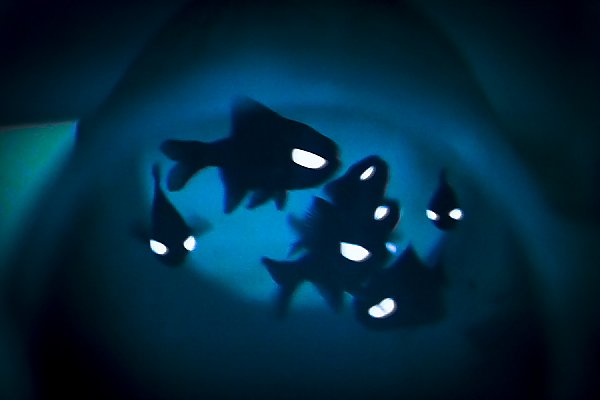Splitfin Flashlight Fish
Anomalops katoptron
Flashlight fish live in the Indo-Pacific Ocean and Caribbean Sea. These fish have organs near their eyes that contain bioluminescent bacteria that emit light. The fish can rotate the light organs to flicker on and off to detect prey in the dark.

SPECIES IN DETAIL
Splitfin Flashlight Fish
Anomalops katoptron
CONSERVATION STATUS: Data deficient
CLIMATE CHANGE:
At the Aquarium
Flashlight fish are in the Glowing Reef exhibit in the Tropical Pacific Gallery as part of Coral Reefs: Nature’s Underwater Cities.
Geographic Distribution
This species is found in the Pacific Ocean, from Indonesia and the Philippines to Tuamoto Islands, south to the Great Barrier Reef and north to southern Japan.
Habitat
They are typically found in caves or dark overhangs along steep drop-offs in or near coral reefs.
Physical Characteristics
Flashlight fish have a fusiform black body with blue edging on the dorsal and caudal fins. Conspicuous bean-shaped light organs below each eye are inhabited by symbiotic bioluminescent bacteria. These bacteria grow in tubular structures within the light organs. Light emitted by the bacteria may be blue, white, or yellow. The light emitted by the bacteria is enhanced by a reflector on the back of the light organ.
Size
These fish grow to 4 to 12 inches (10 to 30 centimeters) average length. The maximum recorded length is 14 inches (35 centimeters).
Diet
These fish feed on zooplankton and use their flashing bioluminescent bacteria to help locate prey.
Reproduction
Little is known about this species’ reproduction. It is believed that they are broadcast spawners.
Behavior
Flashlight fish are nocturnal and live in schools. They hide in caves or dark overhangs during the day to avoid sunlight.
Adaptation
This fish uses its flashing light patterns while swimming a zigzag pattern to evade and confuse predators. They can also confuse predators by rotating their light organs to “turn them off.”
Longevity
Unknown
Conservation
This species has not been evaluated by the International Union for Conservation of Nature. It faces threats from climate change and ocean pollution.
SPECIES IN DETAIL | Print full entry
Splitfin Flashlight Fish
Anomalops katoptron
CONSERVATION STATUS: Data deficient
CLIMATE CHANGE:
Flashlight fish are in the Glowing Reef exhibit in the Tropical Pacific Gallery as part of Coral Reefs: Nature’s Underwater Cities.
This species is found in the Pacific Ocean, from Indonesia and the Philippines to Tuamoto Islands, south to the Great Barrier Reef and north to southern Japan.
They are typically found in caves or dark overhangs along steep drop-offs in or near coral reefs.
Flashlight fish have a fusiform black body with blue edging on the dorsal and caudal fins. Conspicuous bean-shaped light organs below each eye are inhabited by symbiotic bioluminescent bacteria. These bacteria grow in tubular structures within the light organs. Light emitted by the bacteria may be blue, white, or yellow. The light emitted by the bacteria is enhanced by a reflector on the back of the light organ.
These fish grow to 4 to 12 inches (10 to 30 centimeters) average length. The maximum recorded length is 14 inches (35 centimeters).
These fish feed on zooplankton and use their flashing bioluminescent bacteria to help locate prey.
Little is known about this species’ reproduction. It is believed that they are broadcast spawners.
Flashlight fish are nocturnal and live in schools. They hide in caves or dark overhangs during the day to avoid sunlight.
This fish uses its flashing light patterns while swimming a zigzag pattern to evade and confuse predators. They can also confuse predators by rotating their light organs to “turn them off.”
Unknown
This species has not been evaluated by the International Union for Conservation of Nature. It faces threats from climate change and ocean pollution.

